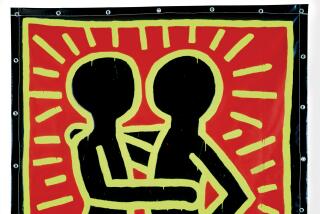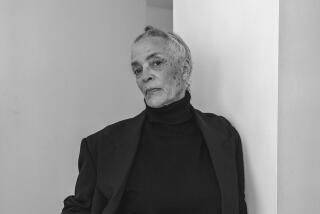Keith Haring, Pop star and lawbreaker, gets a Google Doodle
Keith Haring, recipient Friday of a Google Doodle, was among a group of art school students who considered themselves Pop Art heirs to Andy Warhol. But although Haring was dead by age 31, the artist made his own imprint, and it wasn’t on a soup can.
Perhaps as remarkable as Haring’s art was the man himself -- his energy and personality.
In a 2008 review of a Haring documentary, Los Angeles Times’ movie critic Kenneth Turan says Haring’s lively pop sensibility, “owlish looks” and exuberant personality combined to make him, as one of his friends said, “a true phenomenon.”
Haring grew up in Kutztown, Pa., where he was a diligent paper boy, delivering the Reading Eagle seven days a week. He was interested in art as a boy and would draw comic strips with his father, cartoonist Allen Haring.
But his destiny was bigger and much more offbeat, and by the time he moved to New York in 1978 to attend the School of Visual Arts, he was diving into the street art scene and becoming a fixture at local clubs.
He was a regular at Paradise Garage, a multimedia dance club in SoHo. And, along with Madonna, the B52s, Kenny Scharf and others, he was well-known at Club 57 in New York’s East Village. There, Haring put on art exhibitions and read his poetry.
In “Keith Haring Journals,” the artist talked about his newfound love of poetry with trademark enthusiasm and eloquence: “I have been enlightened. I have fallen into poetry and it has swallowed me up.”
Around this same time, he was making his mark in the world of graffiti art. In New York at the end of the ‘70s, there was “a band of creative people who marked out their territory around SoHo and the East Village,” according to an essay for the 2005 exhibition in Milan, Italy, “The Keith Haring Show.”
In 1982, Haring picked up a piece of chalk and joined their ranks. As a graffiti artist, he went to the New York subways and put his stamp on the blank black advertising panels there, but he wasn’t into the “culture of the tag.”
Haring’s impulse was to bring art to the people.
He’s famous for his large outdoor murals, which he created in cities including Chicago and Atlanta as well as Berlin, Melbourne, Australia and Rio de Janiero. As the Encyclopedia Britannica notes, he was often assisted in these endeavors by scores of children, who shared with him his sense of play.
Haring opened the Pop Shop in New York City in 1986, marketing T-shirts, pin-on buttons and original prints. As Gianni Mercurio notes in his 2005 essay, some controversy erupted over the legitimacy of this commercial operation, as well as Haring’s advertisements for Absolut Vodka and designs for Swatch Watch. And yet he was beloved by the activist community and seen as consistently counter-cultural in spirit.
In the course of his short life, Haring was a passionate cultural activist. Although he at one time used psychedelic drugs, he went on to try to discourage the use of crack cocaine -- he famously painted his “Crack Is Wack” mural on the handball court walls at what is now called the Crack Is Wack Playground in New York City.
Haring also fought to arrest the spread of AIDS, with which he was diagnosed as an adult.
As Turan says in his 2008 review: “Whereas many artists get less interesting when they become famous, Haring became more so. That’s because of the sincerity and intensity of his impulse, visible in that subway work, to bring art to the people. Accessibility was a key concept for him, and whether it was opening a store called the Pop Shop in SoHo or doing elaborate drawings on give-away Tshirts, he held true to his beliefs.”
Haring would have been 54 today.
ALSO:
Saluting the rock star of opera
Doodle honors a man who did not invent the zipper
AP apologizes to the reporter who got fired after reporting WWII’s end
amy.hubbard@latimes.com
More to Read
Sign up for Essential California
The most important California stories and recommendations in your inbox every morning.
You may occasionally receive promotional content from the Los Angeles Times.











